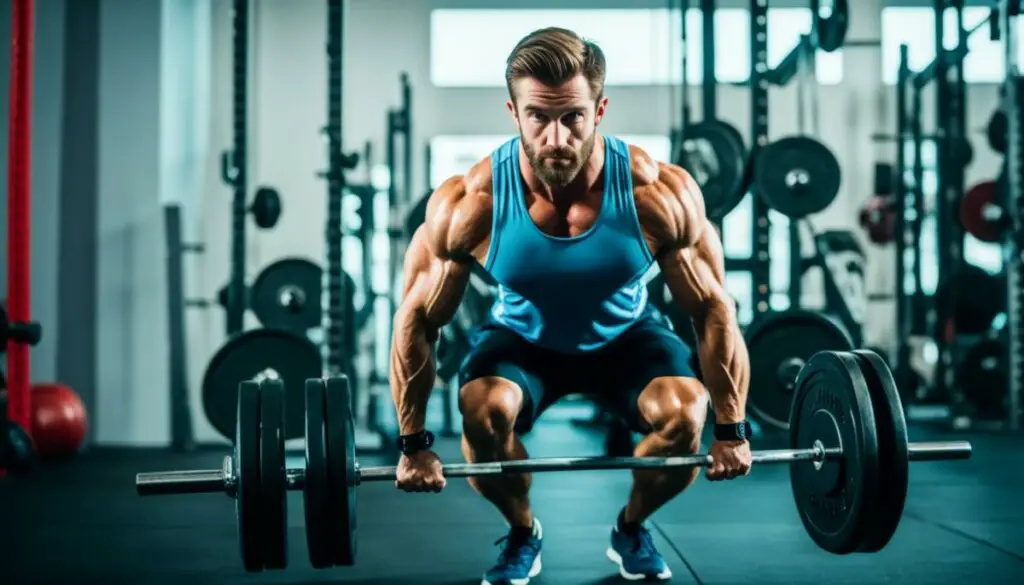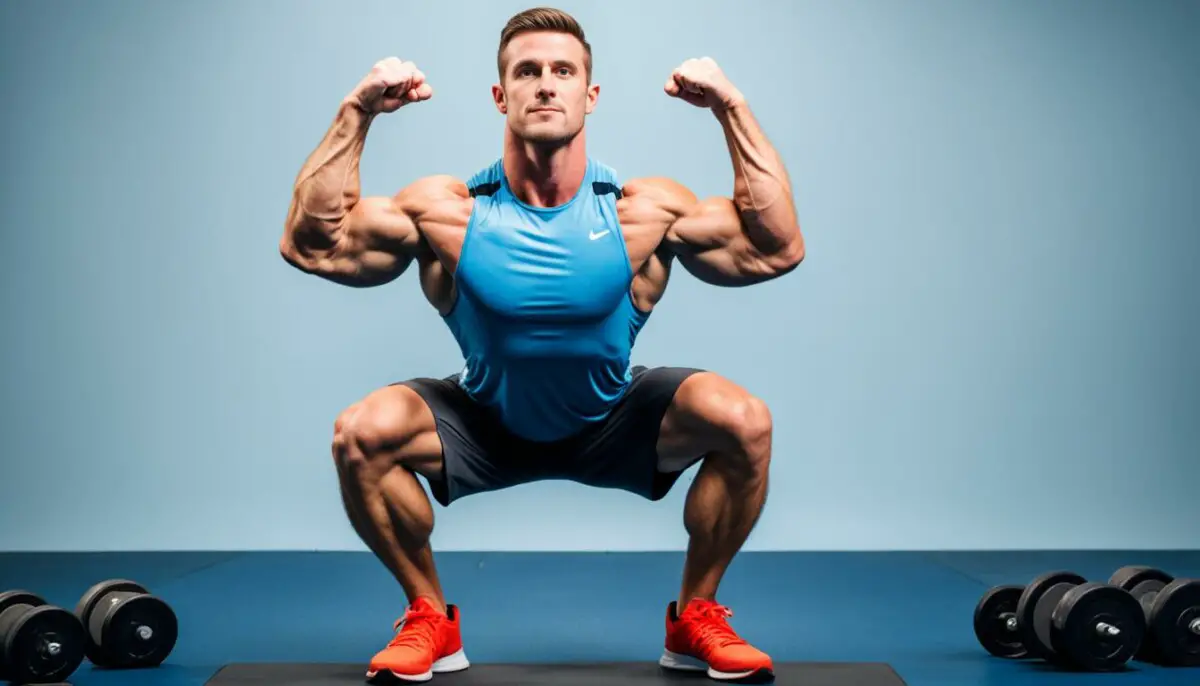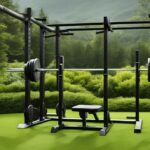Last Updated on 3 months by Francis
Squatting with plates under the heels is a technique that offers numerous benefits for improving squat form and increasing strength. By elevating the heels, this technique improves ankle mobility, enhances range of motion, and promotes a more upright torso during the squat. It also targets specific muscle groups, reduces stress on the knees, optimizes biomechanics, provides a varied training stimulus, and adapts to individual anatomical considerations. However, it’s important to assess individual comfort, biomechanics, and training goals before incorporating this technique into a workout routine.
Contents
Key Takeaways
- Squatting with plates under the heels enhances ankle mobility and range of motion.
- The technique promotes a more upright torso and targets specific muscle groups.
- It reduces stress on the knees and optimizes biomechanics.
- The varied training stimulus and adaptability make it valuable for strength development.
- Assess individual comfort, biomechanics, and training goals before incorporating this technique.
Benefits of Squatting with Plates Under Heels

Squatting with plates under the heels offers a range of benefits that can enhance your squatting technique and overall strength development. Let’s explore the advantages this technique provides:
- Improved Ankle Mobility: Elevating the heels with plates helps mitigate ankle mobility issues, allowing for a fuller range of motion during the squat.
- Enhanced Range of Motion: By elevating the heels, squatting with plates enables a deeper squat, engaging the muscles more effectively and promoting better muscle activation throughout the movement.
- Targeted Muscle Activation: Squatting with plates under the heels emphasizes quadriceps and glute engagement, helping you develop strength in these key muscle groups.
- Better Posture: The elevated heel position encourages a more upright torso, reducing the risk of leaning forward and putting excessive strain on the lower back.
- Reduced Stress on the Knees: Squatting with plates can help optimize biomechanics and provide a more comfortable squatting position, potentially reducing stress on the knees.
- Varied Training Stimulus: Incorporating plate squat variations into your workouts adds variety to your routine, keeping your muscles challenged and promoting continuous progress.
- Adaptability: Plate squat progressions allow you to adjust the height of the elevation, making it suitable for individuals of different fitness levels and anatomical considerations.
With all these benefits, it’s clear that squatting with plates under the heels can be a valuable addition to your training regimen, helping you improve your squat form, increase strength, and target specific muscle groups.
Drawbacks of Squatting with Plates Under Heels
While the technique of squatting with plates under the heels offers several benefits, it is important to be aware of the drawbacks as well. Addressing these drawbacks can help ensure proper squat form and prevent potential issues.
One drawback of squatting with plates under the heels is the possibility of a forward torso inclination. If proper form is not maintained, this can strain the lower back and lead to discomfort or injury. It is crucial to focus on maintaining a neutral spine position throughout the squat movement.
Another drawback to consider is that squatting with plates under the heels primarily addresses limited ankle dorsiflexion rather than directly targeting the underlying cause of the issue. Proper ankle mobility is essential for a well-executed squat, and relying solely on external support may not address the root cause of limited ankle mobility in the long term.
Additionally, using external support like elevated heels can potentially limit natural ankle mobility and compromise foot stability. It is important to understand that relying on equipment like weightlifting shoes or plates may not translate well to different training environments or situations where such equipment is not available.
To mitigate these drawbacks, individuals should prioritize developing proper squat form and strengthening their ankles and lower legs. This can be achieved through exercises that specifically target ankle mobility and dorsiflexion, as well as incorporating balance and stability training into their routine.
Overall, while squatting with plates under the heels can be a useful technique for addressing limited ankle mobility, it is important to be mindful of the potential drawbacks and work towards long-term solutions that promote proper squat form and overall lower body strength.
How to Perform Elevated Squats Correctly
Performing elevated squats correctly involves proper equipment and technique. To maximize the benefits of elevated squats, follow this step-by-step guide:
- Equip yourself with weightlifting shoes or shoes with an elevated heel to provide stability and enhance squat mechanics.
- Ensure you have weight plates or an elevated surface to elevate your heels.
- Begin by setting up with your feet shoulder-width apart or wider, with your toes pointing slightly outwards.
- Position the barbell on the upper back or across the front of the shoulders, maintaining a neutral curvature of the spine.
- Engage your core and shoulders while maintaining a relaxed grip on the barbell.
-
“Remember to squat while keeping the weight on your heels and maintaining a more vertical torso.”
- Slowly lower yourself into the squat position, ensuring your knees track over your toes and maintaining a tight core.
- Raise yourself back up to the starting position while focusing on driving through your heels.
- Gradually progress by adding weight and adjusting the elevation of your heels as needed.
- Pay close attention to your form throughout the movement, with a focus on maintaining proper squat positioning and a controlled descent and ascent.
By following these steps and paying attention to your squat setup and positioning, you can perform elevated squats correctly and maximize the benefits of this technique.
Should You Do Squatting with Plates Under Heels?

Squatting with plates under the heels can be a beneficial technique, especially for individuals who have mobility constraints or want to focus on their quadriceps during squats. By elevating the heels with plates, the center of balance shifts, making it easier to achieve proper squat depth with less ankle and hip mobility required. This technique is particularly beginner-friendly, helpful for taller lifters, and can aid in improving front squats.
However, it is important to note that squatting with plates under the heels may not be the ideal long-term solution for improving squat form. While it can provide temporary benefits, addressing the underlying mobility constraints and working on overall squat technique is crucial for long-term progress. Additionally, individuals with specific mobility limitations should consider consulting with a fitness professional to determine the best approach for their unique needs.
Remember, squatting with plates under the heels is just one technique among many. There are other effective squat variations and exercises that can target similar muscle groups and provide a range of benefits. Exploring different options and finding what works best for your body and fitness goals is key.
Consider Alternatives
If you’re looking for alternative squat variations, here are a few options to consider:
- Barbell front squats: Emphasizes quadriceps and upper back strength.
- Goblet squats: Builds quad strength and offers a different weight dispersion.
- Bulgarian split squats: Improves muscle imbalance and balance.
- Overhead squats: Enhances body control and mobility.
- Sissy squats: Isolates and targets the quadriceps.
These alternatives provide a variety of options that can cater to different goals and preferences. Experimenting with different squat variations can help you discover exercises that work best for your body and provide the desired training stimulus.
| Squatting with Plates Under Heels | Alternative Squat Variations |
|---|---|
| Good option for beginners and individuals with mobility constraints | Provides a range of options for different goals and preferences |
| Places more emphasis on quadriceps | Targets a variety of lower body muscles |
| Can aid in improving front squats | Offers different weight dispersion and muscle activation |
| Not ideal for long-term squat form improvement | Provides alternative exercises to prevent monotony |
Alternative Squat Variations
In addition to squatting with plates under the heels, there are several alternative squat variations that can provide similar benefits. These variations offer options for individuals with different goals and preferences.
Barbell Front Squat
The barbell front squat is a variation that emphasizes quadriceps and upper back strength. By positioning the barbell on the front of the shoulders, this squat variation targets the quads and engages the upper back for stability.
Goblet Squat
The goblet squat is another effective alternative to consider. This squat variation involves holding a weight or kettlebell at chest level while performing the squat. It helps build quad strength and provides a different dispersion of weight compared to traditional squats.
Bulgarian Split Squat
The Bulgarian split squat is a unilateral squat variation that focuses on improving muscle imbalance and balance. With one foot placed behind on an elevated surface, this squat variation targets the quads, hamstrings, and glutes while improving stability and coordination.
Overhead Squat
The overhead squat is a demanding variation that enhances body control and mobility. It involves holding a barbell overhead while performing the squat. This squat variation engages the core, shoulders, and upper back, promoting overall stability and mobility.
Sissy Squat
The Sissy squat is a unique variation that isolates and targets the quads. By leaning back and lowering the body while keeping the heels elevated, this squat variation intensifies the load on the quads, helping to improve quad strength and definition.
Explore these alternative squat variations to add variety and challenge to your training routine. Incorporating different squat variations can help target specific muscle groups, improve stability, and enhance overall squat performance.
Benefits of Barbell Back Squat
The barbell back squat is widely recognized as one of the most effective exercises for developing lower-body strength and achieving hypertrophy. This fundamental compound movement engages multiple muscle groups, with a particular emphasis on the posterior chain, which includes the glutes, hamstrings, and spinal erectors.
Performing the barbell back squat with proper form and technique is crucial for maximizing its benefits and preventing injury. By maintaining a neutral spine, activating the core, and executing a full range of motion, you can target the desired muscle groups and optimize your results.
Key Benefits
Here are some key benefits of incorporating the barbell back squat into your strength training routine:
- Posterior Chain Power: The barbell back squat targets the glutes, hamstrings, and spinal erectors, helping to develop overall posterior chain power. This translates to improved athletic performance in activities such as sprinting, jumping, and lifting heavy objects.
- Hypertrophy: Due to its ability to recruit a large number of muscle fibers, the barbell back squat is an effective exercise for promoting hypertrophy in the lower body. This means increased muscle size, strength, and definition.
- Lower Body Strength: The barbell back squat is unparalleled in its capacity to build lower body strength. By challenging your muscles through a full range of motion and progressively increasing the load, you can develop stronger legs, hips, and lower back.
To further illustrate the benefits of the barbell back squat, consider this table that compares its effectiveness to other lower-body exercises:
| Exercise | Primary Muscle Groups | Benefits |
|---|---|---|
| Barbell Back Squat | Glutes, Hamstrings, Spinal Erectors | Develops posterior chain power, promotes hypertrophy, and improves lower body strength |
| Lunge | Quadriceps, Hamstrings, Glutes | Targets individual leg muscles, improves balance and stability |
| Leg Press | Quadriceps, Hamstrings, Glutes | Allows for heavier loads, emphasizes quadriceps engagement |
| Deadlift | Glutes, Hamstrings, Spinal Erectors | Strengthens posterior chain, enhances overall strength |
“The barbell back squat is an essential exercise for anyone looking to build lower body strength, develop their posterior chain, and achieve hypertrophy. With proper form and progressive overload, you can unlock the full potential of this compound movement.” – Fitness Expert
In conclusion, incorporating the barbell back squat into your workout routine can yield remarkable results in terms of posterior chain power, hypertrophy, and lower body strength. By prioritizing proper form, progressively increasing the load, and adhering to a well-rounded training program, you can take advantage of the numerous benefits offered by this cornerstone exercise.
Conclusion
Squatting with plates under the heels is a valuable technique that can greatly benefit your squat form, strength, and muscle targeting. By elevating the heels, this technique improves ankle mobility, enhances your range of motion, and promotes better posture. It also reduces stress on the knees, allowing for a safer and more effective squat. Incorporating proper squat techniques, such as this one, can lead to significant strength training benefits.
However, it’s important to remember that individual comfort, biomechanics, and training goals should be taken into consideration before incorporating this technique into your workout routine. It may not be suitable for everyone, so it’s essential to listen to your body and make adjustments accordingly.
Additionally, there are various effective squat variations that provide a range of options for individuals with different goals and preferences. Whether it’s the barbell front squat, the goblet squat, the Bulgarian split squat, the overhead squat, or the Sissy squat, these variations offer alternatives that can help you achieve your fitness objectives.
In conclusion, finding the proper squat technique and incorporating effective squat variations are key to maximizing your strength training benefits. Remember to focus on correct form, listen to your body, and explore different options to find what works best for you. With dedication and consistency, you can achieve great results and take your strength training to new heights.
FAQ
What are the benefits of squatting with plates under heels?
Squatting with plates under the heels offers benefits such as improved ankle mobility, enhanced range of motion, better posture, reduced stress on the knees, improved quadriceps activation, optimized biomechanics, varied training stimulus, and adaptability.
Are there any drawbacks to squatting with plates under heels?
One drawback is the possibility of a forward torso inclination, which can strain the lower back if proper form is not maintained. Another drawback is that this technique primarily addresses limited ankle dorsiflexion rather than addressing the underlying cause of the problem. Additionally, relying on external support like elevated heels can potentially limit natural ankle mobility and compromise foot stability.
How do I perform elevated squats correctly?
To perform elevated squats, you will need weightlifting shoes or shoes with an elevated heel and weight plates or an elevated surface. Start by setting up with feet shoulder-width apart or wider and toes pointing slightly outwards. Position the barbell on the upper back or across the front of the shoulders, maintaining a neutral curvature of the spine and engaging the core and shoulders. Squat while keeping the weight on the heels and maintaining a more vertical torso.
Is squatting with plates under heels suitable for everyone?
Squatting with plates under the heels can be a good option for individuals who struggle with mobility constraints or who wish to place more emphasis on their quadriceps during squats. However, it may not be the ideal long-term solution for improving squat form, and it is important to consider individual goals and mobility limitations.
What are some alternative squat variations I can try?
Alternative squat variations that provide similar benefits include the barbell front squat, goblet squat, Bulgarian split squat, overhead squat, and Sissy squat. These variations offer options for individuals with different goals and preferences.
What are the benefits of the barbell back squat?
The barbell back squat is the gold standard for lower-body exercises and offers benefits such as strengthening the entire lower-body musculature, with a particular emphasis on the posterior chain (glutes, hamstrings, spinal erectors), and promoting overall lower-body strength and hypertrophy.









